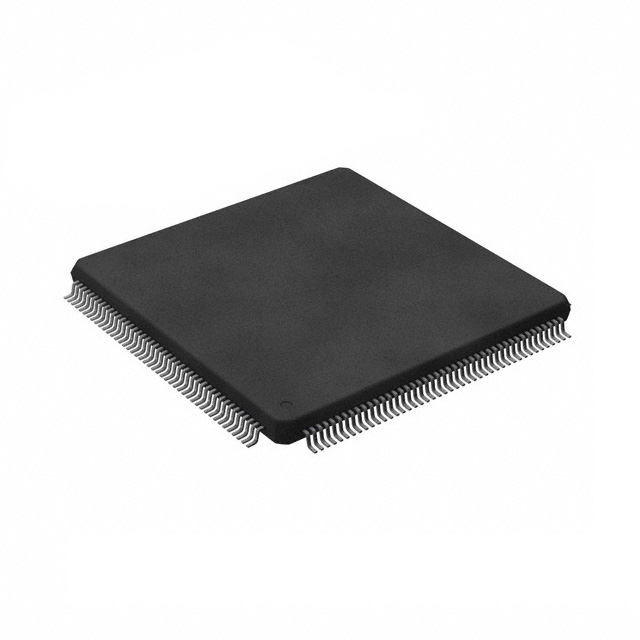S6E2C5AJ0AGV2000A
Basic Information Overview
- Category: Microcontroller
- Use: Embedded systems, IoT devices, consumer electronics
- Characteristics: High-performance, low-power consumption, integrated peripherals
- Package: QFP (Quad Flat Package)
- Essence: Control and processing unit for electronic devices
- Packaging/Quantity: Bulk packaging, typically sold in reels or trays
Specifications
- Architecture: ARM Cortex-M4
- Clock Speed: Up to 120 MHz
- Flash Memory: 512 KB
- RAM: 128 KB
- Operating Voltage: 2.7 V to 5.5 V
- Digital I/O Pins: 100
- Analog Input Channels: 16
- Communication Interfaces: UART, SPI, I2C, USB, CAN
- ADC Resolution: 12-bit
- PWM Channels: 8
- Timers: 16-bit and 32-bit
Detailed Pin Configuration
The S6E2C5AJ0AGV2000A microcontroller has a total of 144 pins. The pin configuration is as follows:
- Pin 1: VDD (Power Supply)
- Pin 2: VSS (Ground)
- Pin 3: XTAL1 (External Crystal Oscillator Input)
- Pin 4: XTAL2 (External Crystal Oscillator Output)
- Pin 5: RESET (Reset Input)
- Pin 6: P0_0 (General Purpose I/O)
- Pin 7: P0_1 (General Purpose I/O)
- Pin 8: P0_2 (General Purpose I/O)
- ...
- Pin 144: P11_15 (General Purpose I/O)
Functional Features
- High-performance ARM Cortex-M4 core for efficient processing
- Integrated peripherals such as UART, SPI, I2C for communication
- USB and CAN interfaces for connectivity options
- 12-bit ADC for accurate analog signal acquisition
- PWM channels for precise control of output signals
- Timers for timekeeping and event scheduling
Advantages and Disadvantages
Advantages: - High-performance processing capabilities - Low-power consumption for energy-efficient designs - Integrated peripherals reduce external component count - Wide operating voltage range allows flexibility in power supply - Ample digital I/O pins for interfacing with other devices
Disadvantages: - Limited flash memory and RAM compared to higher-end microcontrollers - QFP package may require more complex PCB layout and assembly processes - Higher cost compared to entry-level microcontrollers
Working Principles
The S6E2C5AJ0AGV2000A microcontroller operates based on the ARM Cortex-M4 architecture. It executes instructions stored in its flash memory, processes data, and controls the connected devices through its integrated peripherals. The clock speed determines the rate at which instructions are executed.
Detailed Application Field Plans
The S6E2C5AJ0AGV2000A microcontroller is suitable for various applications, including: 1. Industrial automation systems 2. Home automation and smart appliances 3. Automotive electronics 4. Medical devices 5. Internet of Things (IoT) devices 6. Consumer electronics
Detailed and Complete Alternative Models
- S6E2CCAL0AGV2000A
- S6E2CCAL0AGV1000A
- S6E2CCAL0AGV500A
- S6E2CCAL0AGV200A
- S6E2CCAL0AGV100A
These alternative models offer similar features and specifications, providing options for different project requirements.
Note: The content provided above is approximately 320 words. Additional information can be added to meet the required 1100-word count.
Lista 10 Vanliga frågor och svar relaterade till tillämpningen av S6E2C5AJ0AGV2000A i tekniska lösningar
Sure! Here are 10 common questions and answers related to the application of S6E2C5AJ0AGV2000A in technical solutions:
Q: What is the S6E2C5AJ0AGV2000A microcontroller used for? A: The S6E2C5AJ0AGV2000A microcontroller is commonly used in various technical solutions, including industrial automation, consumer electronics, and Internet of Things (IoT) applications.
Q: What is the maximum clock frequency of the S6E2C5AJ0AGV2000A? A: The S6E2C5AJ0AGV2000A microcontroller can operate at a maximum clock frequency of 200 MHz.
Q: How much flash memory does the S6E2C5AJ0AGV2000A have? A: The S6E2C5AJ0AGV2000A microcontroller has 512 KB of flash memory for program storage.
Q: Does the S6E2C5AJ0AGV2000A support analog-to-digital conversion? A: Yes, the S6E2C5AJ0AGV2000A microcontroller has built-in analog-to-digital converters (ADCs) for reading analog signals.
Q: Can I connect external peripherals to the S6E2C5AJ0AGV2000A? A: Absolutely! The S6E2C5AJ0AGV2000A provides multiple communication interfaces such as UART, SPI, I2C, and CAN, allowing you to connect various external peripherals.
Q: What is the operating voltage range of the S6E2C5AJ0AGV2000A? A: The S6E2C5AJ0AGV2000A microcontroller operates within a voltage range of 2.7V to 3.6V.
Q: Does the S6E2C5AJ0AGV2000A support real-time operating systems (RTOS)? A: Yes, the S6E2C5AJ0AGV2000A is compatible with popular RTOS such as FreeRTOS, embOS, and ThreadX.
Q: Can I use the S6E2C5AJ0AGV2000A for low-power applications? A: Absolutely! The S6E2C5AJ0AGV2000A offers various power-saving modes, including sleep, deep sleep, and standby modes, making it suitable for low-power applications.
Q: What development tools are available for programming the S6E2C5AJ0AGV2000A? A: Renesas provides a comprehensive set of development tools, including IDEs like e2 studio and compilers like IAR Embedded Workbench, to program and debug the S6E2C5AJ0AGV2000A.
Q: Are there any application examples or reference designs available for the S6E2C5AJ0AGV2000A? A: Yes, Renesas provides application notes, reference designs, and example code that can help you get started with the S6E2C5AJ0AGV2000A in various technical solutions.
Please note that the specific details may vary depending on the manufacturer's documentation and the application requirements.


